What would happen if we put architects in charge instead of politicians?
This is the question that the Brazilian city of Curitiba asked itself in the 1960s and 70s. The answer would radically reshape the city and catapult Curitiba into the limelight as the “ecological capital of the world.”
Branded as one of the world’s first and most influential green cities, Curitiba became a model of sustainability in a time when that word was just beginning to enter people’s vocabulary. The echo of its contributions to public transit, urban planning, and environmental restoration can be heard in cities all over the world to this day.
The rise and decline of Curitiba is a paradoxical tale of concentric rings and radiating lines, accordion buses and verdant parkways, powerful visionaries and harsh realities.
Like all cities that survive into the future, it is a story of growth.
What makes Curitiba’s story unique is what it decided to do about that growth.
The history of Curitiba
The capital of the state of Paraná in southern Brazil, Curitiba (pronounced “kur-uh-cheeba”) is the nation’s seventh largest city. The name comes from the words curiy (“pine”) and tiba (“abundance”) in guarani, the language spoken by the indigenous peoples of the region.
The city was founded in 1693 by Portuguese and Spanish colonists who came to the area in search of gold. Settlers from all over the world began trickling in, but mass-urbanization would remain a distant glimmer on the horizon for many years to come, with the first census in 1872 putting the population at around 13,0000 souls.
Things began to change, however, when a railroad built in the 1850s connected Curitiba to São Paulo in the north and the Port of Paranaguá in the east, transforming this once sleepy hamlet of cattle farmers into a popular regional trading post. The first major growing pains came in the middle of the 20th Century, as Curitiba began transitioning away from agriculture towards an industrialized urban economy. Within the span of 50 years, the number of citizens ballooned from about 50,000 to 360,000 by the 1960s, putting the city on track for meteoric growth in the decades to follow (Macedo 2013).
By the 2000s, the population would surpass 1 million. Today, Curitiba is home to about 1.9 million people–3.8 million if you include the 26 municipalities in its ever-expanding metropolitan area.
As cars and people continued to pile into its narrow streets, Curitiba’s leaders began to wonder: How were they going to keep the city from collapsing under the weight of its own rapid growth?
How Curitiba became a sustainable city: a tale of two plans
The answer came in the form of two master plans, both of which played a role in elevating this inconspicuous Brazilian city as one of the earliest and most influential models of sustainable urban planning.
The Agache Plan
Curitiba’s first master plan was authored in 1943 by French urbanist Donat-Alfred Agache, who had also planned Rio de Janeiro a little more than a decade earlier.
The Agache Plan laid out a radial design to accommodate the growth of the city in all directions: Like ripples in a pond, Curitiba’s streets would flow outward from its center in a sweeping pattern of concentric rings, linking the city’s heart to its periphery and opening up space for new housing and transportation corridors.
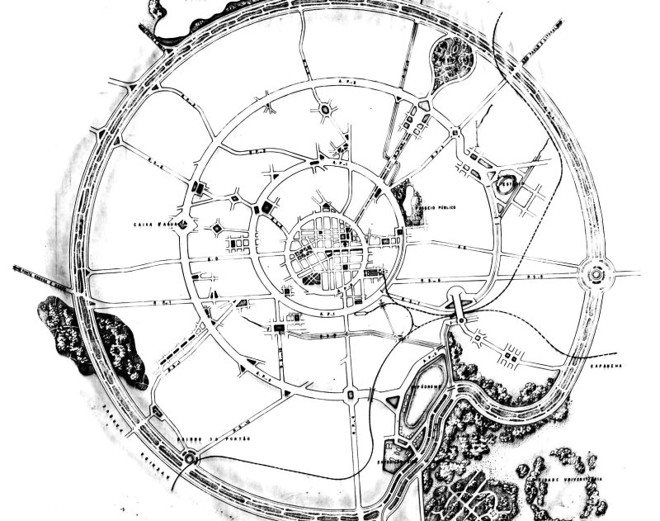
The Agache Plan was never fully realized as the city didn’t have enough funds, but its design continued to guide urban development well into the 1960s, leading to the creation of separated residential and commercial zones, widened boulevards, and improved stormwater systems.
The Agache Plan envisioned a city dominated by cars. It was in opposition to this vision that Curitaba’s second master plan was born.
The Wilheim Plan
The Agache Plan had been a good start, but Curitiba was still bursting at the seams. As the city’s population grew, traffic congestion, crime, and housing shortages climbed right along with it. Feeling the pressure, mayor Ivo Arzua Pereira had an idea: In 1964, he invited six companies to submit entries for a new master plan to address the city’s mounting growth problem.
The winning submission was authored by architect Jorge Wilheim and a team of urban planners from the Federal University of Paraná. This new plan wove green spaces throughout the city, protected historic sites, and picked up where Agache left off: layering amidst the rings a set of axial roadways that fanned out from downtown like spokes on a bicycle, directing growth outward along their linear paths.
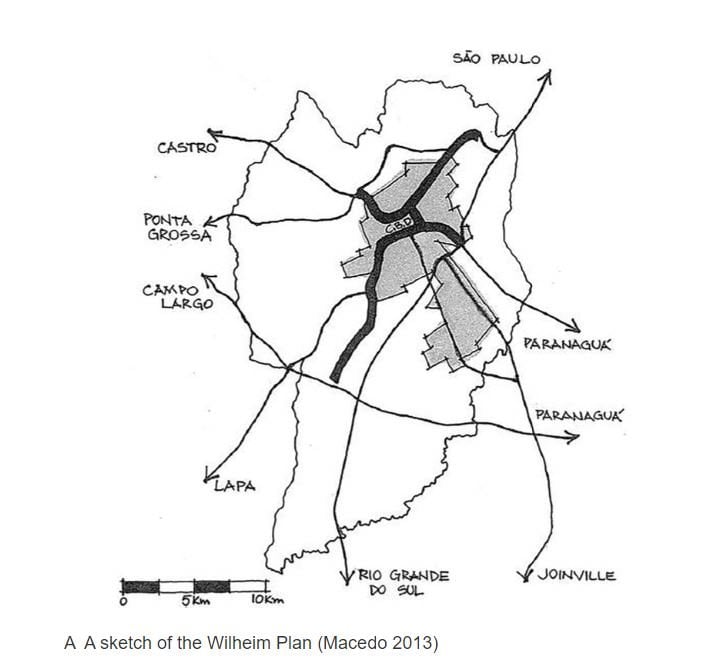
With this new master plan came a marked departure in philosophy about land use and transportation. Agache’s vision had created segregated residential and commercial zones. Wilheim, on the other hand, called for the intermingling of homes and businesses in high-density and mixed-use configurations. The Wilheim, or Curitiba Master Plan, also set the stage for the city's crowning achievement: a radical shift away from cars and towards public transportation (Macedo 2013).
Designing Curitiba: Jaime Lerner and the IPPUC
The story of Curitiba’s bold urban planning cannot be told without acknowledging the influence of its most famous mayor: Jaime Lerner.
Wilheim had drafted a winning master plan that held up mass-transit and land integration as solutions to Curitiba’s growth crisis. It fell to Lerner, a fellow architect and urban planner, to translate that vision into a reality.
First appointed in 1971 at the age of 33, Lerner served three terms as Curitiba’s mayor (1971–1975; 1979–1984; and 1989–1992) and twice as the governor of Paraná before his death at 83 in the spring of 2021. By the end of his life, he would be recognized as an urban planner of legendary and international renown.
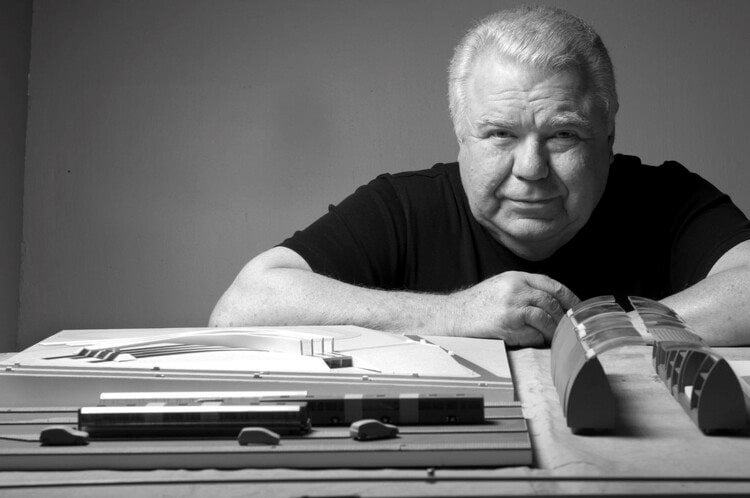
Before occupying the mayor’s office, he served as the director of the Institute of Research and Urban Planning of Curitiba ( its Portuguese acronym is IPPUC), a taskforce created to execute the city’s new master plan. With Lerner at the helm, this scrappy team of architects, urban planners, and engineers, ushered in a host of revolutionary citywide reforms (Larbi 2022).
Their biggest target was the car.
Lerner despised cars, deriding them once as the “cigarette[s] of the future.” He saw it as his mission to take back Curitiba’s streets for human beings, and the young architect-mayor was willing to do everything in his power to accomplish it.
In an infamous episode during his first term as mayor in 1972, Lerner ordered a “lightning transformation” of six blocks of one of the city’s busiest streets into a pedestrian mall. Brushing off the protests of area shop owners concerned that the move would hurt their businesses, he commanded city workers to complete the retrofit over the weekend, before anyone could file a court injunction to stop it.
When motorists threatened to drive through the brand new plaza the following week, Lerner is said to have assembled a gathering of hundreds of teachers and children to paint the street in their path. The motorists turned away and to the surprise of many, foot traffic to area businesses actually increased. The Rua das Flores pedestrian mall has been an icon of Curitiba ever since and has expanded from six blocks to fifteen (Macedo 2013).
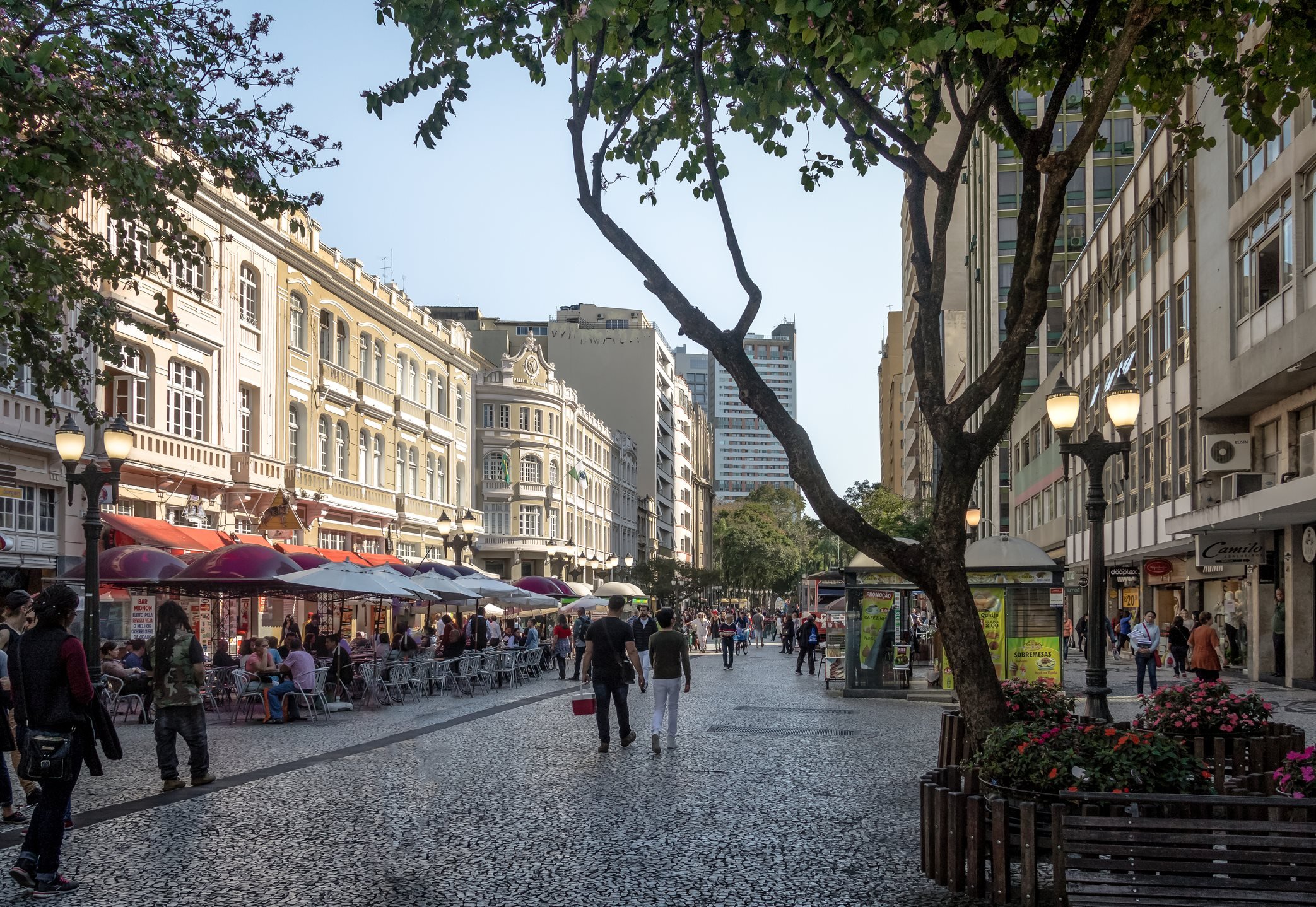
“It was to say, ‘This is being done for children and their parents — don’t even think of putting cars there,’” Lerner said in a 2007 interview with the New York Times.
“We were trying to say, ‘This city is not for cars.’”
Lerner would go on to oversee many other successful “urban acupunctures,” as he called them, breathing new life into key points of the city with creative panache. Seeking to raise consciousness about the environment, his administration also introduced a forward-thinking recycling program; built a Free Environmental University; and wove hundreds of square meters of green space, forests, lakes, and public parks into the fabric of the city.
These and other actions served to boost the city’s profile as “the ecological capital of the world” (Macedo 2013).
The reform that Lerner is most well known for, however, is Curitiba’s innovative public transit system: the Rede Integrada de Transporte.
Curitiba’s Bus Rapid Transit (BRT) system
In most cities, public transit is an afterthought that follows already ingrained street patterns. In Curitiba, it’s the other way around. The physical layout of the city as it exists today grew from the routes of its ground-breaking bus rapid transit system.
A bus rapid transit system (BRT) is a form of public transportation that features fast, efficient, comfortable, and low-cost buses, often kept in dedicated lanes. Launched in the 1970s, the Rede Integrada de Transporte in Curitiba was the very first one ever built (Lindau 2010).
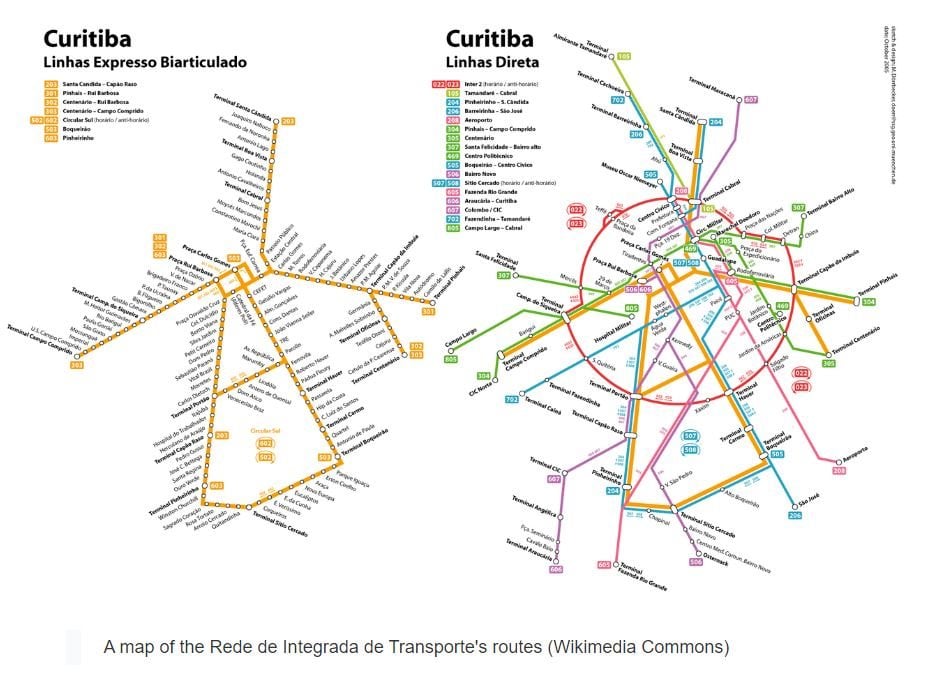
The IPPUC had initially considered a subway system, but it ended up being too expensive. According to one estimate, a subway would cost roughly $60 to $70 million per kilometer of track to build. A bus system, on the other hand, would cost much less at about $200,000 per kilometer (Rabinovich 1996). Buses, Lerner insisted, were the way to go.
The Rede Integrada de Transporte was the Wilheim Plan come to life: The structural axes of the updated street layout divided the city into five transit corridors, with public buses as the dominant form of traffic. In a major departure from most city streets, each axis was built as a trinary road system, with two dedicated bus lanes running down the center and higher speed lanes along the edges for cars and other vehicles. The routes sculpted the city’s skyline, with mixed use high-density blocks hugging the axial arteries, while lower density blocks clustered along the fringes.
This unique configuration positioned Curitiba as one of the forerunners of transit-oriented development, a New Urbanist approach to sustainable city planning that emphasizes compact, mixed-use urban environments built around robust public transit systems (Lindau 2010).
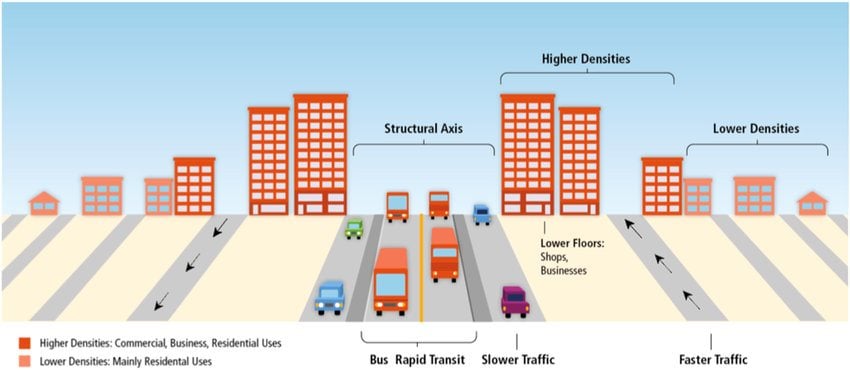
The trinary road system was ingenious for another reason: separating the different types of traffic reduced congestion and made for faster, more reliable buses. High efficiency combined with a low fare made the Rede Integrada de Transporte increasingly attractive to city residents. Why drive to work when you can skip the traffic jams and get a faster, cheaper ride on the bus?
The strategy paid off. About 54,000 passengers took the bus every day upon the system’s launch in the 1970s. By 2007, the Rede Integrada de Transporte’s fleet had grown to about 2,200, and was totalling more than 2 million passenger trips per day (Lindau 2010). At its height, according to the Guardian, roughly 85 percent of Curitiba’s population rode the city’s buses as their exclusive form of long-range transportation.
Lerner and his team at the IPPUC were winning the war against the car.
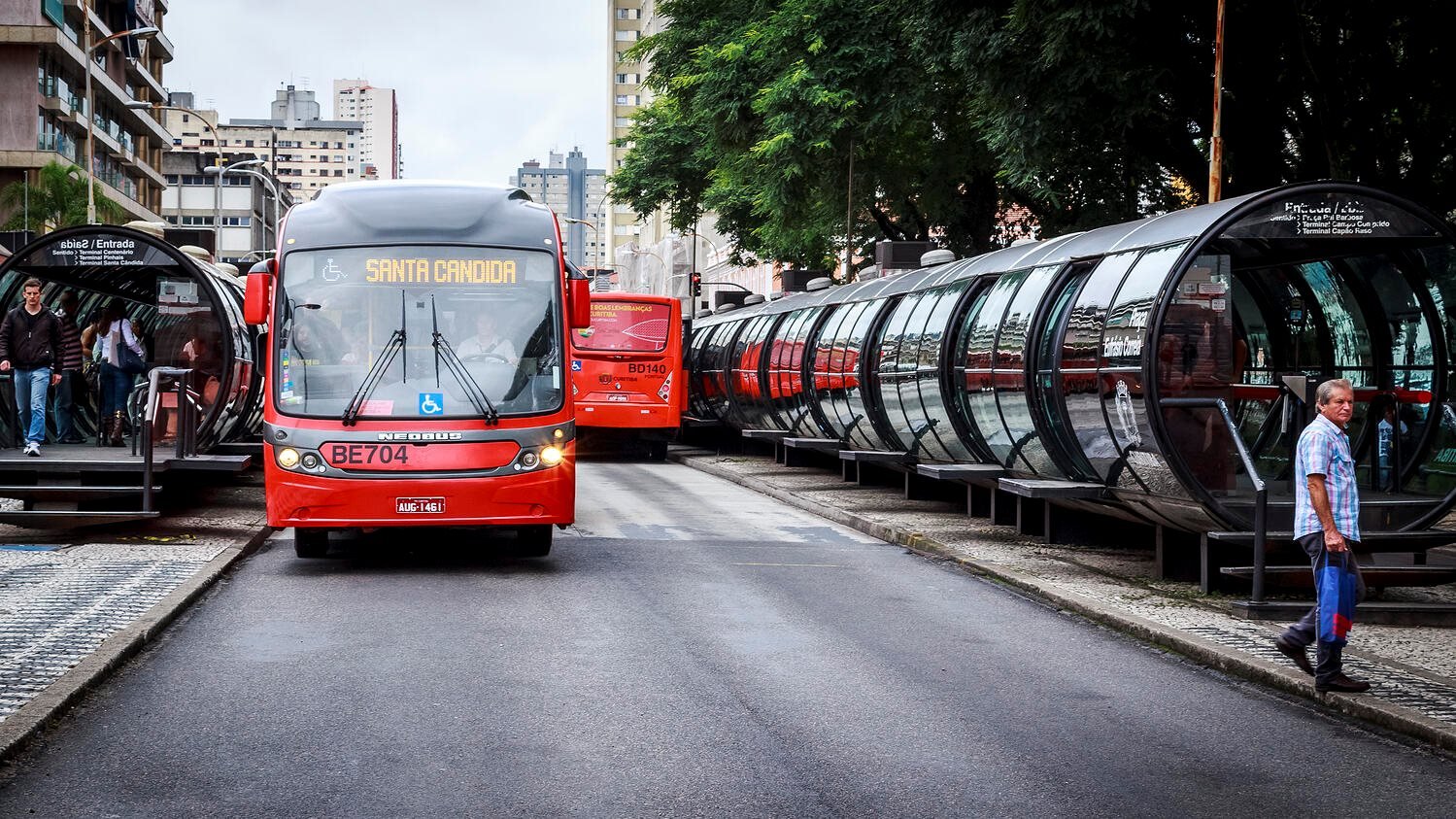
Together, they continued to finetune the Rede Integrada de Transporte throughout the 1980s and ‘90s. Futuristic tube stations provided shelter and a quicker, more efficient method for passengers to board and exit buses. Innovative waste management programs incentivized citizens to recycle in exchange for fresh produce and free bus tickets. Other improvements included the introduction of bi-articulated accordion-style buses that could fit 250 passengers instead of the standard 120 and ran on biodiesel fuel, which emitted 70 percent less carbon dioxide than traditional buses (Lindau).
Lerner’s prioritization of the environment, public-transit, high-density, and mixed-use development revolutionized the city seemingly overnight. Finally, after decades of planning, Curitiba had succeeded at channeling its growth and secured its destiny as a model of bold, low-cost, and sustainable urban planning.
Criticism of Curitiba
Despite its storied ascent, Curitiba’s status as a green city has grown somewhat tarnished in recent years.
Today, Curitiba’s carbon footprint is double that of its larger neighbor, São Paulo, and ridership on the Rede Integrada de Transporte has declined by nearly 14 million passengers (Larbi 2022). Ironically, it also now has more cars per resident than any other city in Brazil (Lindau 2010).
The reason why is the same as it ever was: growth. Wilheim based his vision on a city of 500,000. Today, the population has swelled to nearly 2 million, with an additional 3 million or so in the outlying metropolitan region. As one critic has pointed out, the Rede Integrada de Transporte terminates at the city limits, leaving scant transportation options for workers who live farther from the heart of Curitiba. Curitiba’s master plan may have done a good job of managing growth within its urban core, but it completely failed to address suburban sprawl in its ever-expanding periphery.
The city’s much lauded reforms also came at a cost that often goes unmentioned: Mass urban restructuring led to the demolition of favelas and the forced relocation of entire neighborhoods (Larbi), contributing to the city’s current shortage of affordable housing (Duarte 2012). For these and other reasons, some detractors have questioned if Curitiba was ever truly a sustainable city to begin with, chalking up its reputation to clever “greenwashed” branding by Lerner and others (Macedo 2013).
Finally, it’s impossible to ignore the political realities that shaped Curitiba’s radical transformation. In the 1970s, Brazil was under the repressive regime of a military dictatorship that tortured and executed political dissidents. It was this dictatorship that appointed Lerner as mayor in 1971 (Macedo 2013).
Granted, Lerner’s administration ultimately proved a popular one, enough so that he went on to be democratically elected in his third and final term as mayor following the dissolution of the military government. Still, Lerner and his collaborators at the IPPUC maintained virtually complete control of Curitiba’s political and urban destiny for the better part of 50 years, shutting out participation from anyone who didn’t agree with their vision. And as evidenced by his clandestine conversion of the Rua das Flores, Lerner was prone to undemocratic methods of his own, often taking decisive action without waiting for anyone else’s approval.
Takeaways: Leaving Curitiba
Curitiba’s green image is more shot through with gray than what first meets the eye.
And yet the power of its example cannot be denied.
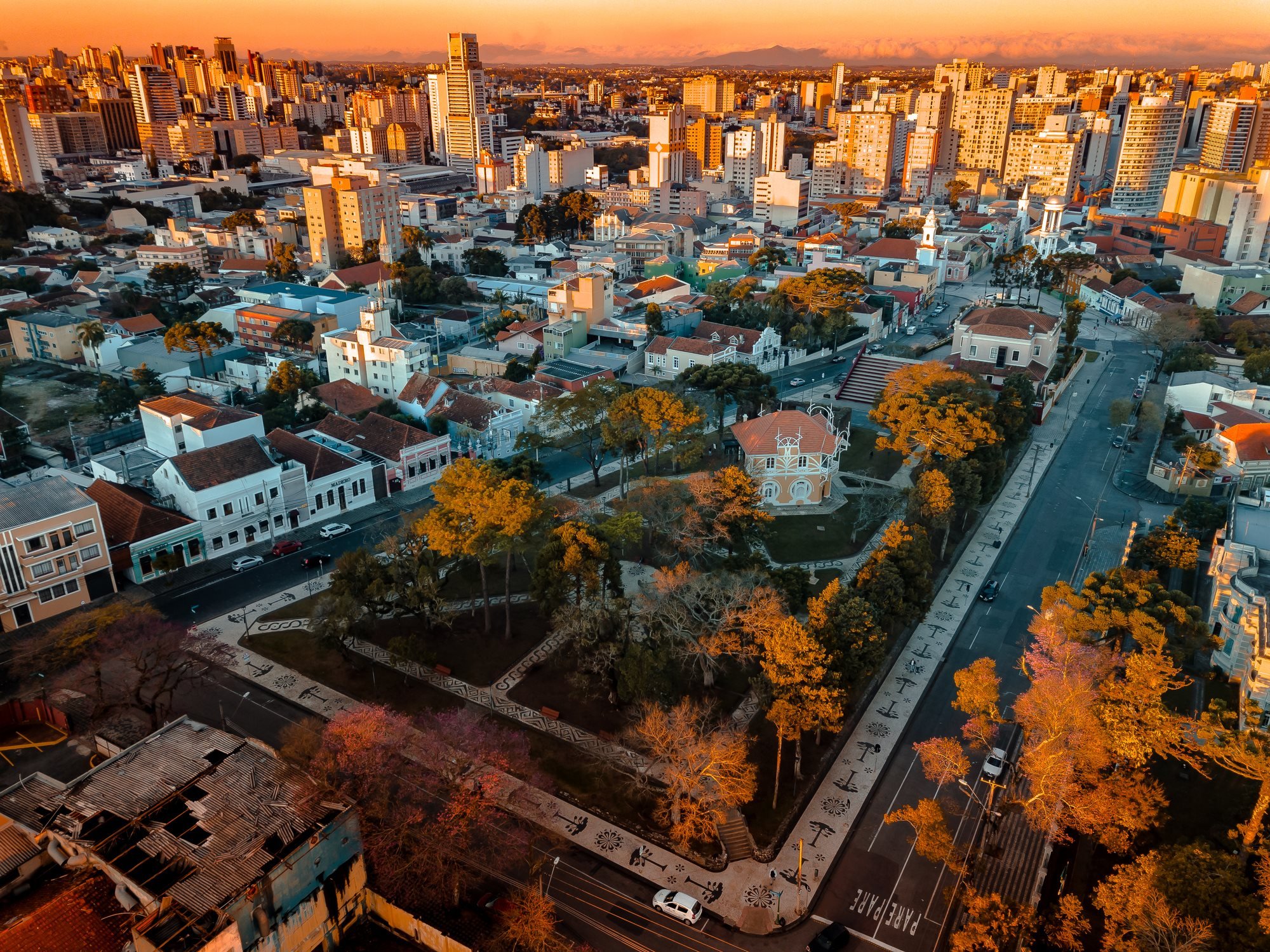
Curitiba set the bar for what it means to be a green city decades before the concept of sustainability was fully understood and embraced in the mainstream. It pioneered an innovative approach to public transit that cut carbon emissions, thinned traffic, channeled growth, and provided affordable rides to millions of city residents. The runaway success of the Rede Integrada de Transporte has inspired an estimated 160 cities around the world to create bus rapid transit systems of their own; including the TransMilenio BRT in Bogotá, Columbia, which has drawn the envious gaze of many cities in the US.
While not beyond reproach, Curitiba’s leaders boldly pursued an imaginative and holistic vision that privileged people over cars and the environment over unchecked development. Ever the optimist, Lerner believed in the power of cities to solve society’s problems, if only we’d design them with thought and care. Before he took the reins, Curitiba had one public park. Today it has dozens and boasts more than 64 square meters of green space per resident, all of which serves to make the city more livable, walkable, and resilient in the face of flooding and the other caprices of climate change (Gustafsson 2016).
Curitiba isn’t the sustainable city it once was, but it continues to evolve. The municipal government has invested $247 million to open up new transit corridors for the Rede Integrada de Transporte, which has integrated electric buses into its fleet. Leadership has also begun to explore the creation of a light-rail subway to supplement its workhorse BRT system.
In the end, no city is perfect. Even one run by architects.
Nevertheless, the city of abundant pines still has many lessons to teach for those who can hear its song.
References
- Duarte, F., & Ultramari, C. (2012). Making public transport and housing match: accomplishments and failures of Curitiba's BRT. Journal of Urban Planning and Development, 138(2).
- Gustafsson , H.-R., & Kelly, E. A. (2016). Ch.5 Developing the Sustainable City: Curitiba, Brazil, as a Case Study. In HOW CITIES WILL SAVE THE WORLD: urban innovation in the face of population flows, climate change ... and economic inequality (pp. 81–94). essay, ROUTLEDGE.
- Larbi, M., Kellett, J., & Palazzo, E. (2022, June). Urban sustainability transitions in the Global South: A case study of Curitiba and Accra. In Urban Forum (Vol. 33, No. 2, pp. 223-244). Springer Netherlands.
- Lindau, L. A., Hidalgo, D., & Facchini, D. (2010). Curitiba, the cradle of bus rapid transit. Built Environment, 36(3), 274-282. https://www.jstor.org/stable/2328971
- Macedo, J. (2013). Planning a sustainable city: The making of Curitiba, Brazil. Journal of Planning History, 12(4), 334-353.
- Pierer, C., & Creutzig, F. (2019). Star-shaped cities alleviate trade-off between climate change mitigation and adaptation. Environmental Research Letters, 14(8), 085011.
- Rabinovich, J., & Leitmann, J. (2019). “Urban Planning in Curitiba” from Scientific American (1996). In Sustainable Urban Development Reader (pp. 429-439). Routledge.